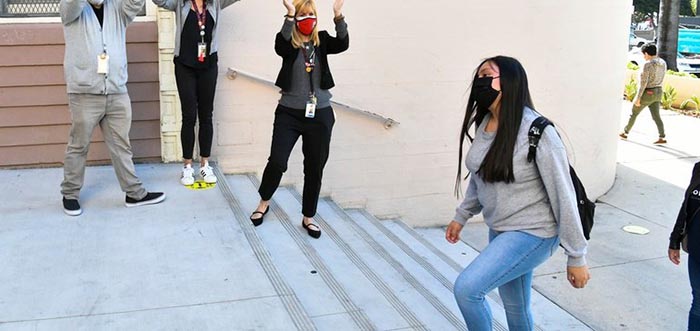
Creative strategies are helping schools engage students in strengthening their social-emotional well-being and soft skills.
From K-12 Dive
By Katie Navarra
March 1, 2022
Before the pandemic, school leaders and teachers recognized the importance of providing social-emotional supports to students by increasing programming, but it took the healthcare crisis to see the bigger issues around some students’ needs.
“The pandemic underscored the importance of SEL. Teachers were able to see some symptoms through behaviors surface at students’ homes,” said Kathleen Walls, director of the Philadelphia-based Southwest Leadership Academy Charter School Behavioral Health Team.
“But even more so, in underscoring the importance of SEL, it is known that if people have a predisposition for a certain condition, it often takes a life-changing event for that to show itself.”
Administrators and teachers recognize there is no one-size-fits-all approach. Many have sought out creative strategies to engage students in areas outside the traditional classroom to support their mental well-being and soft skills development.
“Using resources that you have outside of the school building and getting excited about the possibilities sets the foundation,” said Corie Rushman, high school psychologist at the Hoosick Falls Junior/Senior High School in Hoosick Falls, New York.
Stepping outside the classroom
Rushman’s district has taken this literally, developing an off-site SEL program.
Students in the Hoosick Falls Central School District have access to a unique, hands-on SEL curriculum. They meet at the nearby Higher Ground horse farm for a program designed to teach appropriate social engagement skills, self-discipline, resilience and, at times, remind them how to be a student, explained Rushman.
“Students work individually or within small groups alongside horses and donkeys to practice recognizing and using nonverbal communication skills, empathy and responding to feedback,” she said.
“Equine-assisted therapies have had a strong historical focus on working through trauma. Trauma can look very different for everyone, but it is safe to say that the past year and a half have been very traumatic for many of our students and their families.”
Classrooms of students as young as kindergarten have participated, and smaller group sessions include students in grades 6-12. An average of 20-25 students attend sessions weekly.
“We have seen an increase in compassion and patience with the students attending, and it has been amazing to see them thrive in that setting when they may often shy away in a traditional classroom,” Rushman said.
Making time for mental health practice
A decade ago, the Southwest Leadership Academy Charter School hired Walls to expand its SEL curriculum. At the time, leadership development was the focus, and the school recognized the need for mental and behavioral health learning opportunities.
“Since Southwest Leadership Academy Charter School is an inner-city school that educates children in the busiest police precinct in Philadelphia, we are faced with additional challenges regarding social-emotional learning,” Walls said.
She introduced an annual Mental Health Wellness and Awareness Week, with each day structured around a theme: Mental Monday, Toolbox Tuesday, Wellness Wednesday, Transformation Thursday and Feelings Friday. Each SEL theme is woven into the corresponding day’s lessons alongside leadership characteristics.
Three years ago, she introduced a new concept on Wellness Wednesday — the use of healing frequencies paired with meditation, with particular frequencies incorporated to restore the body and mind.
“We had a couple of classes within the 3rd-grade girls’ class that was rambunctious and causing chaos in the classroom,” Walls said. “As they were settling in, one of the students asked the teacher, ‘Could you please put on that music that we listen to sometimes?’ The fact that this child knew the healing frequencies with meditation was helpful to not only herself but to the class overall amazed me.”
Hosting healthy debate among students
Schools have increasingly incorporated debate teams into their SEL curriculum. For example, more than 50 schools in the Washington, D.C., area have active debate groups, according to David Trigaux, director of programming and development at the Washington Urban Debate League.
Debate helps students develop public speaking skills while also teaching them to think quickly on their feet and never give up — a correlation to the tumultuous pandemic, he explained.
“Students care deeply about the outcome of debate rounds and develop confidence from victories, and resilience from defeats,” he said. “The activity is a great training ground because the outcome of the rounds doesn’t actually matter in the bigger picture of life, but since the students think they do, they get to feel accomplished or resilient without actually risking anything.”
Trigaux said successful debate programs have a strong coach. Picking an enthusiastic educator who can build strong relationships with students is essential.
“Encouraging kids who need to develop different SEL skills creates more impact than simply letting students self-select,” he added.
When in doubt, get creative and look to peers
School leaders and teachers are committed to finding new ideas to enhance and support social-emotional learning, but the most impactful options may be outside the box.
“Don’t be afraid to try something new,” Rushman suggested. “Our district has been very creative and open to new ideas when it comes to meeting students where they need us to.”
“The best resource for teachers is other teachers. There are many Facebook pages and Instagram sites to see what people are using,” said Walls.
Photo: Rodin Eckenroth via Getty Images
Read this and other stories at K-12 Dive

